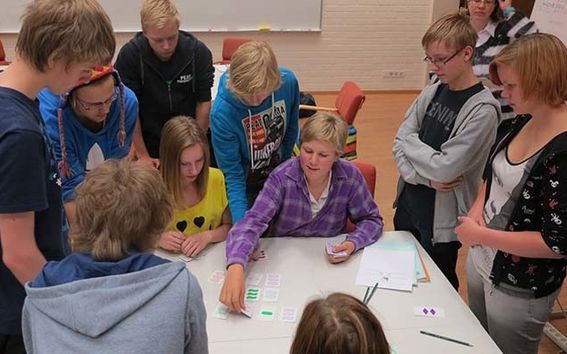Astronomy in the schoolyard

During the past year, Aalto researchers have held more than 100 science sessions at comprehensive schools and upper secondary schools around Finland.
The Scientists in Schools programme involves researchers arranging science sessions and telling pupils about their research in a compelling manner. The objective is to support children's and young people's interest in natural sciences, mathematics, technology and the arts. Aalto researchers have received enthusiastic feedback on the programme from both pupils and teachers.
Astronomer Joni Tammi, who works at the Metsähovi Radio Observatory, is already a pro at holding science sessions. Over the past year he has met over 500 pupils and students ranging from the first year of elementary school to the last year of upper secondary school. The age group he has spoken the most with is 10-11 year-olds, who are learning about the solar system and space in their 4th and 5th grade environmental studies classes. Pupils have learned about the scale and dimensions of the solar system in perhaps a somewhat surprising place, the schoolyard.
'Scale is easier to fully comprehend only after you see a pinhead-sized Earth orbiting a beach ball-sized Sun at a distance of 60 metres at the other end of the schoolyard. The rest of the class time is also calmer after the children have had the chance to run around the sun for a couple "years",' Tammi explains with a smile.
'In astronomy, physics and high-tech often become mixed in with the beauty of the night sky and the mystery of the universe. Pupils are always very interested in the universe and the status of people within it, and sessions include a lot of questions and discussion,' Joni Tammi says.
Brain network researcher Onerva Korhonen has talked to pupils in lower grades about how networks are structured.
'At first I told them what the network model was used for and defined a few terms such as nodes, arches, a node's neighbour and scale. For the remainder of the class, each pupil was given a "identity note card" for a city, after which we built a model of Central Europe's railway network using pieces of rope and produced statistics on the scale of the cities,' Onerva Korhonen describes.
'Unexpectedly, the situation turned into a research simulator! We began by forming a hypothesis, collected data, produced statistics – and found that the hypothesis was correct,' says Korhonen, who is currently working on her doctoral thesis.
Curiosity and fascination as the primary goal
In addition to visiting elementary school pupils, Onerva Korhonen has held sessions for 15-16 year olds, which have dealt with how the human brain functions. According to Korhonen, teachers have requested a session on neuroscience, because there is no room for it in their curriculum. However, the scientists' primary goal is not to teach individual facts, but to promote a curious mind-set.
'It has been fantastic to see that the visits have prompted pupils to think and discuss,' Onerva Korhonen says.
From a teacher's perspective, the programme is a good way to bring diversity to how natural sciences are taught.
'Visits by researchers help pupils better understand how important it is with regard to their further education and working life that they have a basic knowledge of natural sciences. Scientists in Schools visits can also motivate some to study natural sciences,' says Maiju Väyrynen, who teaches mathematics, physics and chemistry at Kruununhaka secondary school.
Both researchers feel that school visits are not only motivating but also fun.
'I feel that school visits have also benefited my pedagogical expertise, as the behaviour and participation of pupils is an immediate sign of which methods are effective and which are not,' Korhonen says.
'When I see children and young people become fascinated by the topics that I have started to take for granted over the years, I experience the wow-effect and sense of mystery once again, which were the things that drew me to this field in the first place,' Tammi says.
'In particular, cutting up rope into pieces was a nice change from working on my doctoral thesis,' Korhonen laughs.
Also read about Professor Patrick Rinke's visit to his old upper secondary school in Germany.
Aalto University's LUMA Centre arranges visits by researcher to all class levels in comprehensive school and upper secondary school. Researchers hold science sessions in the classroom and present their own research in a fun and compelling way on a suitable level for the pupils and students. Schools are not charged for these visits. The Scientists in Schools programme is a part of LUMA activities, i.e. it supports and promotes the teaching and learning of natural sciences, mathematics and technology.
Read more news

DeployAI Partners Gather for Heart Beat Meeting in Helsinki
The European DeployAI project's partners gathered for the Heart Beat meeting hosted by Aalto University Executive Education in Helsinki.
Get to know us: Associate Professor Maria Sammalkorpi
Sammalkorpi received her doctorate from Helsinki University of Technology 2004. After her defence, she has worked as a researcher at the Universities of Princeton, Yale and Aalto.
Aalto computer scientists in ICML 2024
Computer scientists in ICML 2024